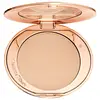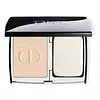Charlotte Tilbury Airbrush Flawless Finish Setting Powder Versus Dior Forever Natural Velvet Compact foundation
What's inside
What's inside
 Key Ingredients
Key Ingredients

 Benefits
Benefits

 Concerns
Concerns

 Ingredients Side-by-side
Ingredients Side-by-side

Talc
AbrasiveMica
Cosmetic ColorantPolymethyl Methacrylate
Dimethicone
EmollientSilica
AbrasivePentaerythrityl Tetraisostearate
EmollientCetearyl Ethylhexanoate
EmollientZinc Stearate
Cosmetic ColorantZea Mays Starch
AbsorbentChlorphenesin
AntimicrobialPotassium Sorbate
PreservativeTocopheryl Acetate
AntioxidantPei-10
Propylene Glycol
HumectantPrunus Amygdalus Dulcis Oil
Skin ConditioningRosa Multiflora Flower Wax
Skin ConditioningTetrasodium EDTA
Water
Skin ConditioningDimethiconol
EmollientTilia Cordata Flower Extract
Skin ConditioningMethylparaben
PreservativeEthylparaben
PreservativePropylparaben
PreservativeButylparaben
MaskingCI 77891
Cosmetic ColorantIron Oxides
Talc, Mica, Polymethyl Methacrylate, Dimethicone, Silica, Pentaerythrityl Tetraisostearate, Cetearyl Ethylhexanoate, Zinc Stearate, Zea Mays Starch, Chlorphenesin, Potassium Sorbate, Tocopheryl Acetate, Pei-10, Propylene Glycol, Prunus Amygdalus Dulcis Oil, Rosa Multiflora Flower Wax, Tetrasodium EDTA, Water, Dimethiconol, Tilia Cordata Flower Extract, Methylparaben, Ethylparaben, Propylparaben, Butylparaben, CI 77891, Iron Oxides
Synthetic Fluorphlogopite
Mica
Cosmetic ColorantCalcium Sodium Borosilicate
Silica
AbrasiveButylene Glycol Dicaprylate/Dicaprate
EmollientBoron Nitride
AbsorbentZinc Stearate
Cosmetic ColorantCaprylic/Capric/Succinic Triglyceride
EmollientPolyglyceryl-2 Triisostearate
EmulsifyingPentylene Glycol
Skin ConditioningWater
Skin ConditioningCaprylyl Glycol
EmollientIris Florentina Root Extract
MaskingEthylhexylglycerin
Skin ConditioningButylene Glycol
HumectantSodium Dehydroacetate
PreservativeParfum
MaskingAluminum Hydroxide
EmollientIsopropyl Titanium Triisostearate
EmollientRosa Centifolia Flower Wax
Skin ConditioningRosa Damascena Flower Wax
MaskingSodium Lauroyl Aspartate
CleansingHydrolyzed Viola Tricolor Extract
Skin ProtectingRosa Multiflora Fruit Extract
MaskingTocopherol
AntioxidantZinc Chloride
AntimicrobialTropaeolum Majus Flower/Leaf/Stem Extract
Skin Conditioning1,2-Hexanediol
Skin ConditioningSodium Benzoate
MaskingPotassium Sorbate
PreservativeCI 77891
Cosmetic ColorantCI 77491
Cosmetic ColorantCI 77492
Cosmetic ColorantCI 77499
Cosmetic ColorantSynthetic Fluorphlogopite, Mica, Calcium Sodium Borosilicate, Silica, Butylene Glycol Dicaprylate/Dicaprate, Boron Nitride, Zinc Stearate, Caprylic/Capric/Succinic Triglyceride, Polyglyceryl-2 Triisostearate, Pentylene Glycol, Water, Caprylyl Glycol, Iris Florentina Root Extract, Ethylhexylglycerin, Butylene Glycol, Sodium Dehydroacetate, Parfum, Aluminum Hydroxide, Isopropyl Titanium Triisostearate, Rosa Centifolia Flower Wax, Rosa Damascena Flower Wax, Sodium Lauroyl Aspartate, Hydrolyzed Viola Tricolor Extract, Rosa Multiflora Fruit Extract, Tocopherol, Zinc Chloride, Tropaeolum Majus Flower/Leaf/Stem Extract, 1,2-Hexanediol, Sodium Benzoate, Potassium Sorbate, CI 77891, CI 77491, CI 77492, CI 77499
 Reviews
Reviews

Ingredients Explained
These ingredients are found in both products.
Ingredients higher up in an ingredient list are typically present in a larger amount.
Ci 77891 is a white pigment from Titanium dioxide. It is naturally found in minerals such as rutile and ilmenite.
It's main function is to add a white color to cosmetics. It can also be mixed with other colors to create different shades.
Ci 77891 is commonly found in sunscreens due to its ability to block UV rays.
Learn more about CI 77891Mica is a naturally occurring mineral used to add shimmer and color in cosmetics. It can also help improve the texture of a product or give it an opaque, white/silver color.
Serecite is the name for very fine but ragged grains of mica.
This ingredient is often coated with metal oxides like titanium dioxide. Trace amounts of heavy metals may be found in mica, but these metals are not harmful in our personal products.
Mica has been used since prehistoric times throughout the world. Ancient Egyptian, Indian, Greek, Roman, Aztec, and Chinese civilizations have used mica.
Learn more about MicaPotassium Sorbate is a preservative used to prevent yeast and mold in products. It is commonly found in both cosmetic and food products.
This ingredient comes from potassium salt derived from sorbic acid. Sorbic acid is a natural antibiotic and effective against fungus.
Both potassium sorbate and sorbic acid can be found in baked goods, cheeses, dried meats, dried fruit, ice cream, pickles, wine, yogurt, and more.
You'll often find this ingredient used with other preservatives.
Learn more about Potassium SorbateSilica, also known as silicon dioxide, is a naturally occurring mineral. It is used as a fine, spherical, and porous powder in cosmetics.
Though it has exfoliant properties, the function of silica varies depending on the product.
The unique structure of silica enhances the spreadability and adds smoothness, making it a great texture enhancer.
It is also used as an active carrier, emulsifier, and mattifier due to its ability to absorb excess oil.
In some products, tiny microneedles called spicules are made from silica or hydrolyzed sponge. When you rub them in, they lightly polish away dead skin layers and enhance the penetration of active ingredients.
Learn more about SilicaWater. It's the most common cosmetic ingredient of all. You'll usually see it at the top of ingredient lists, meaning that it makes up the largest part of the product.
So why is it so popular? Water most often acts as a solvent - this means that it helps dissolve other ingredients into the formulation.
You'll also recognize water as that liquid we all need to stay alive. If you see this, drink a glass of water. Stay hydrated!
Learn more about WaterZinc Stearate is the metal salt of stearic acid. It is a white solid used to bind, thicken, and lubricate products.
This ingredient is common in powder makeup, where it helps keep the powder together.
Zinc Stearate is hydrophobic and repels water.
This ingredient can be sourced from non-animal or animal sources. It is best to reach out to the brand to see where they source this ingredient from.
Learn more about Zinc Stearate